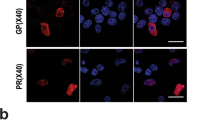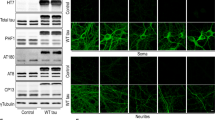Abstract
Expression of the Parkinson’s disease-associated protein α-synuclein causes formation of aggregates and cytotoxicity in a great diversity of transgenic model organisms, in the case of Drosophila melanogaster affecting specific dopaminergic neuron clusters. The relative contribution of α-synuclein misfolding and phosphorylation for neurodegeneration was elucidated in these systems. In transgenic mice, typical neuropathologic inclusions formed concomitant with behavioral deficits, reminiscent of Parkinson’s disease, dementia with Lewy bodies, and multiple system atrophy. Neuronal degeneration was cell-autonomous in the Lewy body disease models, whereas gliotic changes accompanied neurodegeneration caused by (oligodendro)glial cytoplasmic inclusions. These recent findings provided major insights into the molecular mechanisms of α-synucleinopathies.
Similar content being viewed by others
References and Recommended Reading
George JM: The synucleins. Genome Biol 2002, 3:3002.
Chandra S, Gallardo G, Fernández-Chacón R, et al.: α-synuclein cooperates with CSPα in preventing neurodegeneration. Cell 2005, 123:383–396.
Nuscher B, Kamp F, Mehnert T, et al.: α-synuclein has a high affinity for packing defects in a bilayer membrane: a thermodynamics study. J Biol Chem 2004, 279:21966–21975.
Giasson BI, Murray IV, Trojanowski JQ, Lee VM: A hydrophobic stretch of 12 amino acid residues in the middle of α -synuclein is essential for filament assembly. J Biol Chem 2001, 276:2380–2386.
Kahle PJ, Neumann M, Ozmen L, et al.: Selective insolubility of α -synuclein in human Lewy body diseases is recapitulated in a transgenic mouse model. Am J Pathol 2001, 159:2215–2225.
Hashimoto M, Rockenstein E, Mante M, et al.: β-Synuclein inhibits α -synuclein aggregation. A possible role as an antiparkinsonian factor. Neuron 2001, 32:213–223.
Greenbaum EA, Graves CL, Mishizen-Eberz AJ, et al.: The E46K mutation in α -synuclein increases amyloid fibril formation. J Biol Chem 2005, 280:7800–7807.
Singleton A, Gwinn-Hardy K: Parkinson’s disease and dementia with Lewy bodies: a difference in dose? Lancet 2004, 364:1105–1107.
Spillantini MG, Schmidt ML, Lee VM, et al.: α -Synuclein in Lewy bodies. Nature 1997, 388:839–840.
Goedert M: Alpha-synuclein and neurodegenerative diseases. Nat Rev Neurosci 2001, 2:492–501.
Dixon C, Mathias N, Zweig RM, et al.: α -Synuclein targets the plasma membrane via the secretory pathway and induces toxicity in yeast. Genetics 2005, 170:47–59.
Flower TR, Chesnokova LS, Froelich CA, et al.: Heat shock prevents alpha-synuclein-induced apoptosis in a yeast model of Parkinson’s disease. J Mol Biol 2005, 351:1081–1100.
Outeiro TF, Lindquist S: Yeast cells provide insight into α -synuclein biology and pathobiology. Science 2003, 302:1772–1775.
Cooper AA, Gitler AD, Cashikar A, et al.: α -Synuclein blocks ER-Golgi traffic and Rab1 rescues neuron loss in Parkinson’s models. Science 2006, In press. Modifier screens in α SYN yeast models point to an unexpected pathophysiologic role of α SYN in ER-Golgi transport.
Willingham S, Outeiro TF, DeVit MJ, et al.: Yeast genes that enhance the toxicity of a mutant huntingtin fragment or α -synuclein. Science 2003, 302:1769–1772.
Gosavi N, Lee HJ, Lee JS, et al.: Golgi fragmentation occurs in the cells with prefibrillar α -synuclein aggregates and precedes the formation of fibrillar inclusion. J Biol Chem 2002, 277:48984–48992.
Lakso M, Vartiainen S, Moilanen AM, et al.: Dopaminergic neuronal loss and motor deficits in Caenorhabditis elegans overexpressing human α -synuclein. J Neurochem 2003, 86:165–172.
Ved R, Saha S, Westlund B, et al.: Similar patterns of mitochondrial vulnerability and rescue induced by genetic modification of α -synuclein, parkin, and DJ-1 in Caenorhabditis elegans. J Biol Chem 2005, 280:42655–42668.
Cao S, Gelwix CC, Caldwell KA, Caldwell GA: Torsin-mediated protection from cellular stress in the dopaminergic neurons of Caenorhabditis elegans. J Neurosci 2005, 25:3801–3812. This is the first description of TH neuron degeneration in α SYN worms, and this phenotype was rescued by the molecular chaperone torsin A, which in turn is mutated in human dystonia patients, possibly connecting disease mechanisms with PD.
Kuwahara T, Koyama A, Gengyo-Ando K, et al.: Familial Parkinson mutant α -synuclein causes dopamine neuron dysfunction in transgenic Caenorhabditis elegans. J Biol Chem 2006, 281:334–340.
Sawin ER, Ranganathan R, Horvitz HR: C. elegans locomotory rate is modulated by the environment through a dopaminergic pathway and by experience through a serotonergic pathway. Neuron 2000, 26:619–631.
Springer W, Hoppe T, Schmidt E, Baumeister R: A Caenorhabditis elegans Parkin mutant with altered solubility couples α -synuclein aggregation to proteotoxic stress. Hum Mol Genet 2005, 14:3407–3423. This article describes for the first time in a living organism (C. elegans) the interplay of the two most important genetic causes of PD (ie, α SYN and parkin), under environmental stress, and identifies cellular mechanisms implicated in PD.
Auluck PK, Chan HY, Trojanowski JQ, et al.: Chaperone suppression of α -synuclein toxicity in a Drosophila model for Parkinson’s disease. Science 2002, 295:865–868.
Chen L, Feany MB: α -Synuclein phosphorylation controls neurotoxicity and inclusion formation in a Drosophila model of Parkinson disease. Nat Neurosci 2005, 8:657–663.
Feany MB, Bender WW: A Drosophila model of Parkinson’s disease. Nature 2000, 404:394–398.
Pendleton RG, Parvez F, Sayed M, Hillman R: Effects of pharmacological agents upon a transgenic model of Parkinson’s disease in Drosophila melanogaster. J Pharmacol Exp Ther 2002, 300:91–96.
Auluck PK, Meulener MC, Bonini NM: Mechanisms of suppression of α -synuclein neurotoxicity by geldanamycin in Drosophila. J Biol Chem 2005, 280:2873–2878.
Klucken J, Shin Y, Masliah E, et al.: Hsp70 reduces α -synuclein aggregation and toxicity. J Biol Chem 2004, 279:25497–25502.
Fujiwara H, Hasegawa M, Dohmae N, et al.: α -Synuclein is phosphorylated in synucleinopathy lesions. Nat Cell Biol 2002, 4:160–164.
Rathke-Hartlieb S, Kahle PJ, Neumann M, et al.: Sensitivity to MPTP is not increased in Parkinson’s disease-associated mutant α -synuclein transgenic mice. J Neurochem 2001, 77:1181–1184.
Matsuoka Y, Vila M, Lincoln S, et al.: Lack of nigral pathology in transgenic mice expressing human α -synuclein driven by the tyrosine hydroxylase promoter. Neurobiol Dis 2001, 8:535–539.
Richfield EK, Thiruchelvam MJ, Cory-Slechta DA, et al.: Behavioral and neurochemical effects of wild-type and mutated human α -synuclein in transgenic mice. Exp Neurol 2002, 175:35–48.
Masliah E, Rockenstein E, Veinbergs I, et al.: Dopaminergic loss and inclusion body formation in α -synuclein mice: implications for neurodegenerative disorders. Science 2000, 287:1265–1269.
van der Putten H, Wiederhold KH, Probst A, et al.: Neuropathology in mice expressing human α -synuclein. J Neurosci 2000, 20:6021–6029.
Kahle PJ, Neumann M, Ozmen L, et al.: Subcellular localization of wild-type and Parkinson’s disease-associated mutant α -synuclein in human and transgenic mouse brain. J Neurosci 2000, 20:6365–6373.
Neumann M, Kahle PJ, Giasson BI, et al.: Misfolded proteinase K-resistant hyperphosphorylated α -synuclein in aged transgenic mice with locomotor deterioration and in human a-synucleinopathies. J Clin Invest 2002, 110:1429–1439.
Marui W, Iseki E, Nakai T, et al.: Progression and staging of Lewy pathology in brains from patients with dementia with Lewy bodies. J Neurol Sci 2002, 195:153–159.
Freichel C, Neumann M, Ballard T, et al.: Age-dependent cognitive decline and amygdala pathology in α -synuclein transgenic mice. Neurobiol Aging 2006, In press. This study shows that α SYN fibril formation can also occur in cortical brain areas of transgenic mice, correlating with cognitive decline, reminiscent of dementia with LBs.
Giasson BI, Duda JE, Quinn SM, et al.: Neuronal α -synucleinopathy with severe movement disorder in mice expressing A53T human α -synuclein. Neuron 2002, 34:521–533.
Lee MK, Stirling W, Xu Y, et al.: Human α -synuclein-harboring familial Parkinson’s disease-linked Ala-53 --> Thr mutation causes neurodegenerative disease with α -synuclein aggregation in transgenic mice. Proc Natl Acad Sci U S A 2002, 99:8968–8973.
Gomez-Isla T, Irizarry MC, Mariash A, et al.: Motor dysfunction and gliosis with preserved dopaminergic markers in human α -synuclein A30P transgenic mice. Neurobiol Aging 2003, 24:245–258.
Wakabayashi K, Hayashi S, Yoshimoto M, et al.: NACP/ α -synuclein-positive filamentous inclusions in astrocytes and oligodendrocytes of Parkinson’s disease brains. Acta Neuropathol. 2000, 99:14–20.
Lantos PL: The definition of multiple system atrophy: a review of recent developments. J Neuropathol Exp Neurol 1998, 57:1099–1111.
Kahle PJ, Neumann M, Ozmen L, et al.: Hyperphosphorylation and insolubility of α-synuclein in transgenic mouse oligodendrocytes. EMBO Rep 2002, 3:583–588.
Giasson BI, Forman MS, Higuchi M, et al.: Initiation and synergistic fibrillization of tau and alpha-synuclein. Science 2003, 300:636–640.
Stefanova N, Reindl M, Neumann M, et al.: Oxidative stress in transgenic mice with oligodendroglial α -synuclein overexpression replicates the characteristic neuropathology of multiple system atrophy. Am J Pathol 2005, 166:869–876.
Yazawa I, Giasson BI, Sasaki R, et al.: Mouse model of multiple system atrophy: α-synuclein expression in oligodendrocytes causes glial and neuronal degeneration. Neuron 2005, 45:847–859. In this animal model, glial α SYN pathology was found for the first time to be associated with neurodegeneration, suggesting that oligodendrocytes are the primary cell type affected during MSA, followed by secondary neurodegeneration.
Shults CW, Rockenstein E, Crews L, et al.: Neurological and neurodegenerative alterations in a transgenic mouse model expressing human α -synuclein under oligodendrocyte promoter: implications for multiple system atrophy. J Neurosci 2005, 25:10689–10699.
Author information
Authors and Affiliations
Corresponding author
Rights and permissions
About this article
Cite this article
Springer, W., Kahle, P.J. Mechanisms and models of α-synuclein-related neurodegeneration. Curr Neurol Neurosci Rep 6, 432–436 (2006). https://doi.org/10.1007/s11910-996-0025-8
Issue Date:
DOI: https://doi.org/10.1007/s11910-996-0025-8




